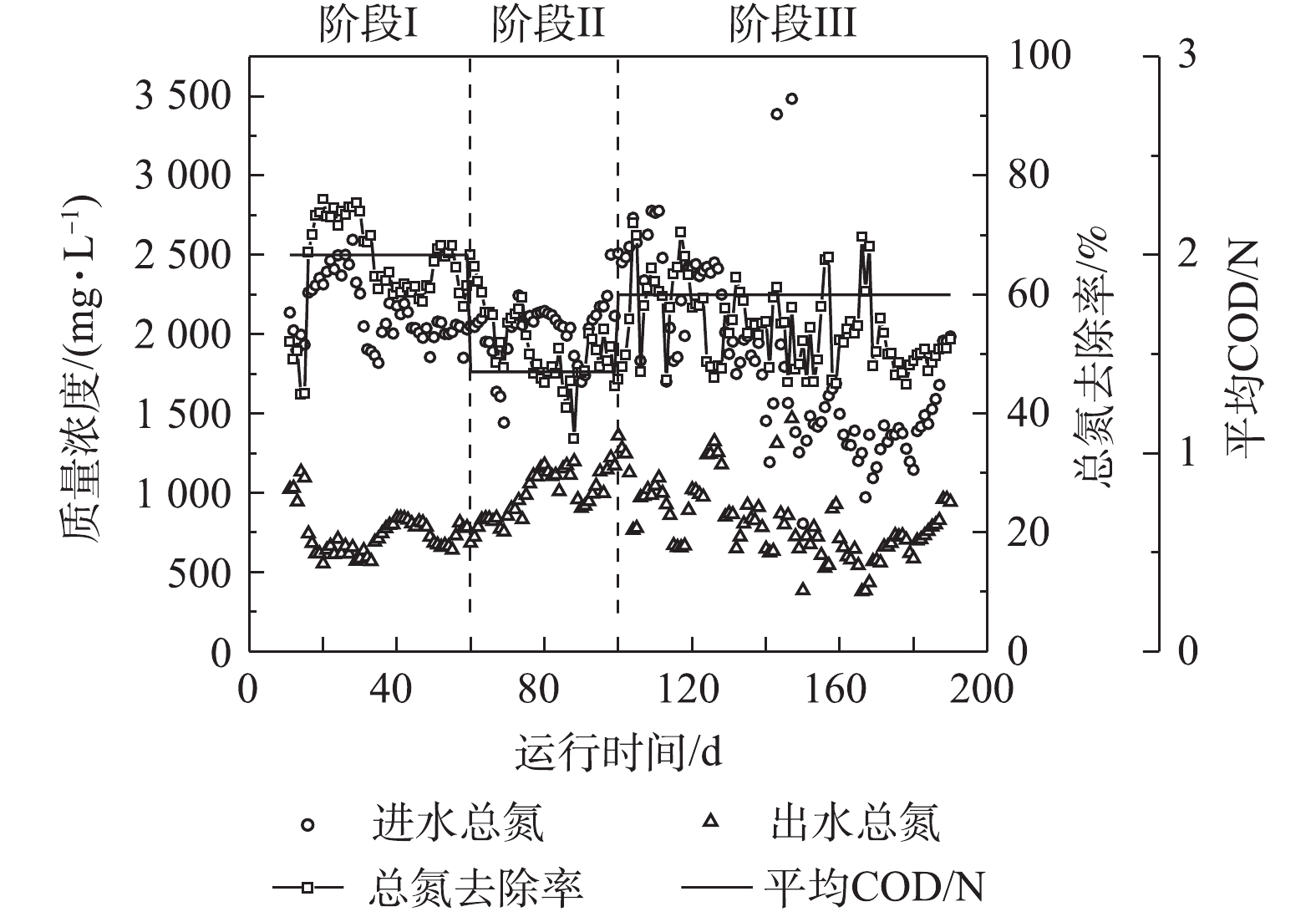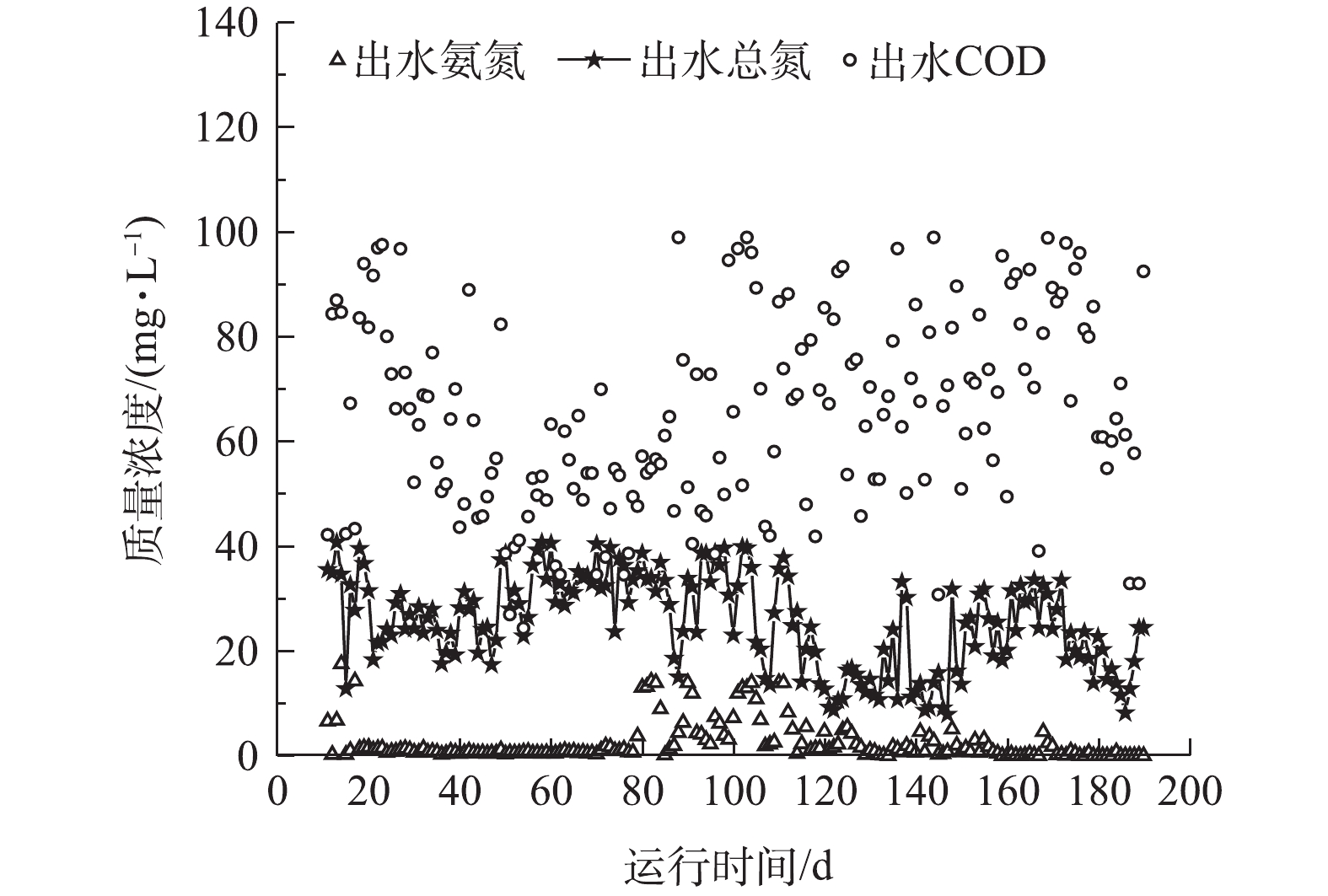-
垃圾渗滤液是生活垃圾在卫生填埋或堆放过程中,由于垃圾内有机物分解、自身水分、以及落在垃圾上的大气降水所形成的一种高浓度废水。垃圾渗滤液水质受垃圾的组成、填埋时间、地质情况、温度和含水量等多种因素影响而变化[1],但其一般特点是高氨氮(氨氮质量浓度为1 000~3 000 mg·L−1)、低碳氮比(老龄垃圾渗滤液COD/N<0.1),有机物种类多且复杂等。垃圾渗滤液若不经处理或处理不当排放至自然环境中,将严重威胁填埋场区域水、土环境的安全[2]。
目前,垃圾渗滤液处理主要采用物化法与生化法相结合的方式,通过预处理、生化处理、深度处理等系列工序达到排放标准[3-4]。吹脱法脱氨效果稳定、氨去除率高,常被用作垃圾渗滤液预处理工艺[5-6]。但吹脱法亦存在明显的缺点[7-8]:操作过程需要大幅度调节 pH、耗费大量酸碱调节药剂、增加成本;使用石灰药剂产生水垢,增大设备维护难度;吹脱产生气态氨,易造成大气污染等。而生物法因为其操作简单、工艺成本低、脱氮高效稳定等特点,逐渐成为国内外填埋场渗滤液脱氮的核心处理技术。但由于垃圾渗滤液碳氮比低,直接采用传统硝化反硝化脱氮工艺处理时,存在碳源投加量大、运行能耗高、脱氮效率低等问题[9-10]。短程硝化反硝化(PND)工艺是指将硝化过程控制在亚硝态氮阶段,再利用反硝化作用直接将亚硝态氮转化为氮气的过程[11]。与传统硝化反硝化相比,理论上可节约25%的耗氧量和40%的碳源量[12]。尽管一些研究者对短程硝化反硝化处理垃圾渗滤液进行了大量研究,通过控制pH、温度、溶解氧、FNA(游离亚硝酸)、FA(游离氨)、污泥龄等条件[13-18]实现亚硝态氮的积累,但研究多为实验室小试实验,大规模应用研究还鲜见报道。
本研究针对深圳市某垃圾渗滤液处理厂氨吹脱预处理工艺存在的脱氮效果不佳、运行费用较高等实际问题,开展了基于短程硝化反硝化的垃圾渗滤液预处理的中试研究。中试处理水量最高可达200 m3·d−1,相当于小型垃圾渗滤液处理厂规模。由于垃圾渗滤液处理厂大多采用膜生物反应器(MBR)多级硝化反硝化技术,为方便渗滤液处理厂进行技术改造,本研究选用AO-SBR反应器开展中试实验。考察了短程硝化反硝化垃圾渗滤液预处理工艺启动及稳定运行控制的影响因素,解析了典型反应周期氮素平衡关系,探讨了短程硝化反硝化作为垃圾渗滤液预处理工艺的可行性。本研究将为垃圾渗滤液处理厂预处理工艺的升级改造提供实验基础与经验参考。
全文HTML
-
AO-SBR工艺主要由调节池、缺氧池、SBR池(好氧池)和储水池组成,各部分有效容积分别为10、95、285、10 m3,实验装置示意图和现场照片见图1。老龄渗滤液取自深圳某垃圾填埋场,主要水质参数为pH=8.3~8.6、碱度7 000~12 000 mg·L−1、COD 1 200~3 000 mg·L−1、总氮1 200~2 700 mg·L−1、氨氮1 000~2 500 mg·L−1。实验中通过气动泵分别在缺氧池和储水池投加甲醇,以提高原水可生化性。接种污泥取自渗滤液处理厂二级AO-MBR好氧池,污泥MLSS浓度为7 086 mg·L−1,MLVSS浓度为5 668 mg·L−1,污泥呈棕黄色。
反应器单个周期运行工序为进水(非限制性曝气)8 h、曝气2 h、沉淀0.5 h、滗水1.5 h,每天运行2个周期。反应器回流比约为4∶1,沉淀与滗水工序时关闭回流。水池外壁安装保温层保持系统温度为35~38 ℃,通过调节鼓风机频率使SBR池DO保持为1~1.5 mg·L−1,通过调节进水量使SBR池pH保持为6.5~7.5。反应器启动阶段不排泥,生化池中污泥浓度始终维持在5 000~6 000 mg·L−1。反应器试运行阶段(1~10 d)主要解决工程问题,并未严格按设计工序运行,因此下述实验数据及分析从运行第11天开始。
-
实验期间定期采样,COD、氨氮、亚硝态氮、碱度等常规水质指标均按国家标准方法[19]进行测定分析;硝态氮采用离子色谱仪(IC-AS23阴离子检测器,DIONEX ICS-600)测定;总氮由总有机碳分析仪(TOC-L CPH/CPN测定仪)测定;DO含量和pH分别使用溶解氧仪 (model 6308DT,Jenco)和pH计(model 3675,Jenco)进行在线测定。
-
系统典型反应周期氮素平衡计算所涉及的生物脱氮反应方程式如式(1)~式(4)所示。亚硝化反应见式(1),硝化反应见式(2),硝化总过程见(3),反硝化过程反应见式(4)。
1.1. 实验装置与运行
1.2. 分析项目与测定方法
1.3. 氮素平衡分析
-
根据进水负荷和脱氮性能,可将AO-SBR反应器运行过程分为3个阶段,各阶段的平均进水氨氮负荷分别为0.376、0.511、0.489 kg·(m3·d)−1;平均水力停留时间(HRT)分别约为5、3.6、3.1 d。
第Ⅰ阶段为启动期(11~60 d),在此阶段的前10 d,氨氮去除率由75%升高至95%,硝态氮质量浓度明显下降,亚硝化率由41.9%升高至99.2%(图2)。这说明此时系统脱氮路径正由全程硝化向短程硝化转变,氧化亚硝态氮的NOB菌活性受到抑制。第21天后亚硝态氮积累率稳定保持在95%以上,标志着系统内短程硝化启动成功。从第30天开始,氨氮去除率下降至90%左右,通过计算发现,第30天SBR池FNA质量浓度最高可达0.221 mg·L−1,处于硝化作用受到抑制的FNA浓度[20]范围内(0.22~0.28 mg·L−1)。但氨氮去除率并未持续下降,这说明硝化作用并没有完全被抑制。第Ⅱ阶段为负荷提升期(61~100 d),该阶段内氨氮去除率由90%下降至80%,进水氨氮负荷增加成为影响硝化反应的主要因素。第Ⅲ阶段为稳定运行期(101~190 d),受填埋场气候及渗滤液水质(尤其氨氮质量浓度)波动的影响,该阶段氨氮去除率不稳定,但基本保持在80%以上。在运行至第146天时,进水氨氮质量浓度高达3 300 mg·L−1,生化反应剧烈放热导致各反应池水温升至最高,为40 ℃,SBR池pH上升至8.0左右。紧急从二级AO-MBR好氧池中回流泥水混合物至SBR池稀释降温。应急处理后系统逐渐恢复正常,当天出水硝态氮质量浓度为60 mg·L−1。除突发情况外,其他运行时段亚硝化率稳定保持在90%以上。在反应器启动初期,出水亚硝态氮质量浓度约为200 mg·L−1,通过调节水量降低SBR池内pH,使FNA质量浓度最高达到0.111 mg·L−1,其处于NOB菌活性完全受到抑制的浓度[20]范围内(0.026~0.22 mg·L−1),而AOB菌活性并未受到影响,因此,使系统中NOB菌逐渐被洗淘,这说明在中试规模下通过控制高浓度FNA可以实现垃圾渗滤液短程硝化反硝化的快速启动和稳定运行。
由于垃圾渗滤液尤其是老龄垃圾渗滤液碳氮比失调,在实验中通过投加甲醇调节原水碳氮比,以提高原水可生化性、实现反应系统高效脱氮,实验结果如图3所示。在第Ⅰ阶段,系统平均COD/N约为2,总氮去除率由70%下降至60%。该阶段内的亚硝态氮逐渐积累,FNA浓度逐渐升高至0.247 mg·L−1。虽然高浓度FNA会影响反硝化菌的活性[20],但总氮去除率没有持续降低,这说明反硝化菌对高浓度FNA产生抗性。第Ⅰ阶段平均ΔCOD/ΔN约为2.1,小于传统硝化反硝化消耗碳氮比2.86,这也侧面证明短程硝化反硝化已经发生。在第Ⅱ阶段,系统平均COD/N下降为1.4,平均ΔCOD/ΔN低至1.8,总氮去除率低至40%,此时COD/N成为制约反硝化脱氮效率的主要因素。在第Ⅲ阶段,平均COD/N上升至1.8,平均ΔCOD/ΔN约为2,总氮去除率基本维持在50%以上。剩余亚硝态氮将在后续EGSB厌氧生物反应器中继续进行反硝化去除。在反应系统运行过程中,垃圾渗滤液原水水质受气候影响变化波动较大,但系统仍能保持稳定脱氮效果,说明该预处理工艺具有一定耐冲击负荷能力。
-
系统中氨氮的去除可能存在多种途径,除了短程硝化反硝化、传统硝化反硝化等生物脱氮路径,反应器利用池底鼓风曝气增加溶解氧的同时,也会使部分游离氨通过曝气方式从水中直接逸散。因此,有必要分析反应系统氮素物料平衡关系,明确氮类污染物主要去向、判断反应器运行状态。
以第Ⅲ阶段稳定运行期第120天的进出水数据(表1)为例,根据生物脱氮反应方程(式(1)~式(4)),由碱度、COD消耗及进出水氮元素物料平衡关系计算,得到AO-SBR典型周期内氮素转化情况(图4)。氮平衡计算结果表明:当AO-SBR反应器进水总氮负荷为0.739 kg·(m3·d)−1时,通过短程硝化反硝化途径去除的总氮负荷为0.323 kg·(m3·d)−1,占据总氮去除负荷的74.8%;而全程硝化反硝化脱氮途径去除的总氮负荷占据总氮去除负荷的13.5%。由此可知,短程硝化反硝化反应是AO-SBR中试反应器脱氮的主要路径。在系统脱氮过程中,COD实际消耗量(2 375.65 mg·L−1,含投加甲醇1 246.07 mg·L−1)远小于仅发生传统脱氮反硝化的理论耗碳量(3 602.94 mg·L−1),节省约34%有机碳源。
-
垃圾渗滤液经AO-SBR预处理工艺脱氮后,还需通过EGSB厌氧生物反应器+AO-MBR+纳滤(NF)等工序,以完成渗滤液处理。EGSB厌氧生物反应器将去除预处理出水中剩余的亚硝态氮和部分COD,预处理+EGSB将共同完成80%总氮去除的任务,AO-MBR工艺去除剩余20%总氮与难降解COD,经NF后的最终出水水质达到《生活垃圾填埋场污染控制标准》即可纳管排放。在中试期间,系统各工艺段出水水质见表2,垃圾渗滤液处理系统出水水质见图5。短程硝化反硝化预处理工艺出水经过后续工艺处理后,均可达到排放标准。以上结果说明,短程硝化反硝化工艺代替氨吹脱方法进行垃圾渗滤液预处理在技术上是可行的。
AO-SBR工艺主要运行成本包括药剂费(甲醇)、电费和人工费;氨吹脱工艺主要运行成本包括药剂费(石灰、硫酸)、电费和人工费。在长期稳定运行的情况下,2种预处理工艺的主要运行费用见表3。未考虑其他少量药剂、设备折旧、日常维修和大修等费用时,AO-SBR作为垃圾渗滤液脱氮预处理工艺,其主要运行成本是氨吹脱的70%左右。此外,AO-SBR工艺自动化程度较高且操作简单。氨吹脱工艺容易产生水垢问题,导致其大修次数远多于AO-SBR工艺;吹脱产生自由氨需要硫酸溶液吸收处理,也会增加相应的人工成本。因此,在整体工艺出水满足纳管要求前提下,作为垃圾渗滤液预处理工艺,AO-SBR较氨吹脱具有明显的经济优势。
2.1. AO-SBR预处理工艺的脱氮效能
2.2. 典型周期氮素平衡分析
2.3. AO-SBR预处理工艺技术及经济可行性分析
-
1)中试规模的AO-SBR短程硝化反硝化垃圾渗滤液预处理工艺脱氮效果良好。当平均进水氨氮负荷为0.489 kg·(m3·d)−1时,氨氮去除率可达80%以上,且碳氮比为1.8时,总氮去除率为50%左右,满足后续工序进水要求。
2)当AO-SBR反应器进水总氮负荷为0.739 kg·(m3·d)−1时,通过短程硝化反硝化途径去除的总氮负荷为0.323 kg·(m3·d)−1,占据总氮去除负荷的74.8%,系统以短程硝化反硝化脱氮途径为主。
3) AO-SBR短程硝化反硝化预处理工艺出水经过后续EGSB厌氧生物反应器、二级AO-MBR、NF工艺处理后可以满足排放标准,AO-SBR主要运行成本为9.571元·m−3,是氨吹脱工艺主要运行成本的70%。




 下载:
下载:





